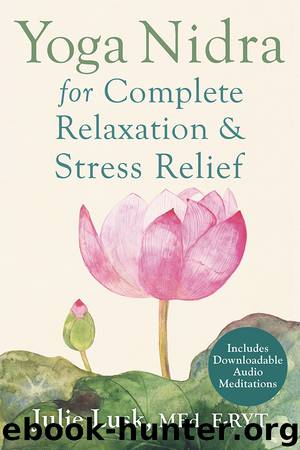Yoga Nidra for Complete Relaxation and Stress Relief by Julie Lusk

Author:Julie Lusk [Lusk, Julie]
Language: eng
Format: epub
ISBN: 9781626251847
Publisher: New Harbinger Publications
Published: 2015-06-30T16:00:00+00:00
Part 4: Remembering the sankalpa
Part 5: Transition and return to full awareness
More specifically, the sequence used in all three yoga nidra experiences in this book follows the same basic map and progression, even if what is done during different parts changes. First, we are guided to become attentive to the here and now by becoming aware of the physical body, starting at the head. This is enhanced by paying attention to sensory input (sights, sounds, breath, feelings, and so on). Next, we move up and down the body, staying in sync with the meridians and major chakras. First on the right side, then the left, and next through the center. This particular sequence benefits the three main nerve channels (the ida, pingala, and sushumna nadis) that span from the base of the spine to the top of the head. (See “Alternate-Nostril Breathing” in appendix 2 for information on these nerve channels.) Crossing attention from one side of the body to the other is done for balancing and building neural pathways. This combined experience is relaxing, healing, and restorative.
Other valuable yoga nidra methods are available that recommend up to ten parts and a variety of formats and sequences. What is important is that they are based on the core principles of yoga nidra and are effective. Once a sequence is established, it is recommended that you stay with it to facilitate and reinforce the flow of energy (prana). You will likely find that repeating the same sequence is relaxing and comforting, and feels awkward when it is changed. N. C. Panda (2003) states in his book Yoga-Nidra, Yogic Trance, “The sequence should be unaltered. Maintenance of the sequence should be strictly followed” (103). He says it is okay and no harm will be done if the sequence is altered during the learning and beginning stages of practice. After a while, the sequence will be memorized and everything will be conditioned.
Richard Miller, the author of Yoga Nidra: The Meditative Heart of Yoga (2005) and founder of the iRest method, takes a slightly different approach. He allows for variations to the yoga nidra practice to meet the particular needs of a group or individual. For example, the usual iRest body scan begins with the mouth and follows a traditional sixty-one-point rotation of consciousness. However, when working with people experiencing sleep-related issues such as insomnia, he recommends beginning the body scan in the feet instead. In another example, when working with those who have experienced facial or pelvic trauma, these areas might initially be avoided so as not to trigger an adverse traumatic effect. The iRest practice is continually monitored, adapted, and changed as each group or person progresses in healing and learning (Miller 2015).
It is recommended that you consider these different approaches to format and sequencing to find out for yourself what works best for you.
Download
This site does not store any files on its server. We only index and link to content provided by other sites. Please contact the content providers to delete copyright contents if any and email us, we'll remove relevant links or contents immediately.
| Acupuncture & Acupressure | Aromatherapy |
| Ayurveda | Chelation |
| Chinese Medicine | Energy Healing |
| Healing | Herbal Remedies |
| Holistic | Homeopathy |
| Hypnotherapy | Massage |
| Meditation | Naturopathy |
| Reference |
Inner Engineering: A Yogi's Guide to Joy by Sadhguru(6725)
The Power of Now: A Guide to Spiritual Enlightenment by Eckhart Tolle(5605)
Fear by Osho(4660)
Ikigai by Héctor García & Francesc Miralles(4125)
The Art of Happiness by The Dalai Lama(4063)
The Ultimate Bodybuilding Cookbook by Kendall Lou Schmidt(3886)
Yoga Therapy by Mark Stephens(3702)
The Little Book of Hygge by Meik Wiking(3647)
The Healing Self by Deepak Chopra(3474)
Why Buddhism is True by Robert Wright(3404)
Being Aware of Being Aware by Rupert Spira(3229)
The Hatha Yoga Pradipika (Translated) by Svatmarama(3229)
Shift into Freedom by Loch Kelly(3134)
Wild Words from Wild Women by Stephens Autumn(3092)
Work Clean by Dan Charnas(3048)
Happiness by Matthieu Ricard(2991)
More Language of Letting Go: 366 New Daily Meditations by Melody Beattie(2966)
Yoga Body & Mind Handbook by Jasmine Tarkeshi(2835)
Why I Am Not a Feminist by Jessa Crispin(2695)
